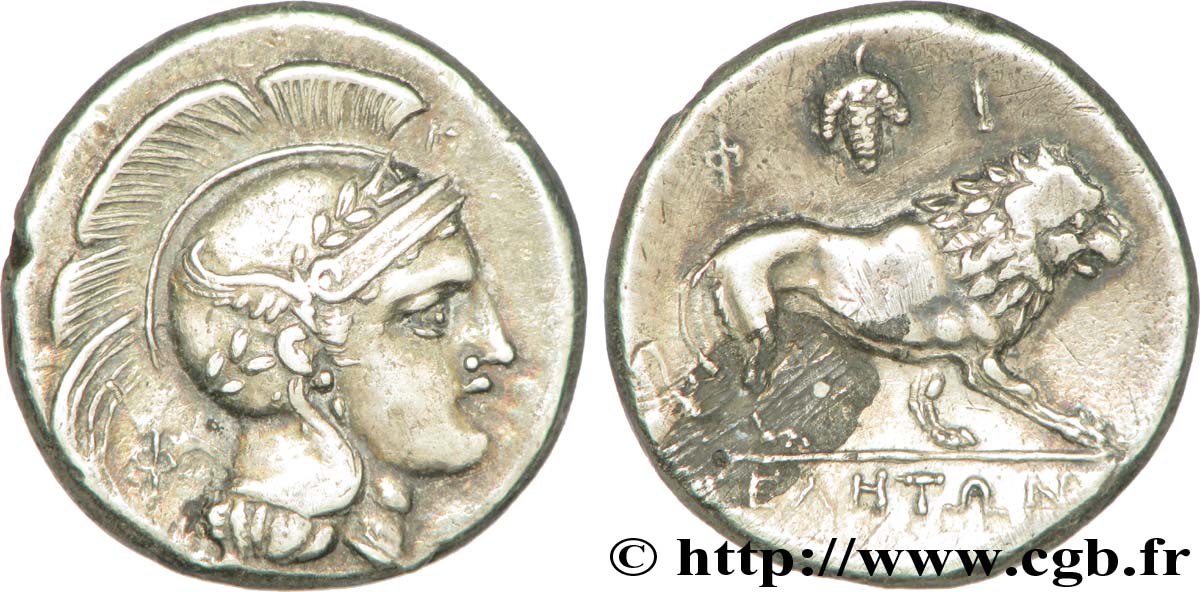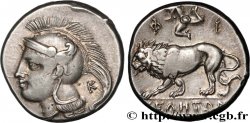v36_0017 - LUKANIEN - VELIA Nomos, statère ou didrachme
MONNAIES 36 (2008)
Startpreis : 350.00 €
Schätzung : 650.00 €
Erzielter Preis : 350.00 €
Anzahl der Gebote : 1
Höchstgebot : 358.00 €
Startpreis : 350.00 €
Schätzung : 650.00 €
Erzielter Preis : 350.00 €
Anzahl der Gebote : 1
Höchstgebot : 358.00 €
Type : Nomos, statère ou didrachme
Datum: c. 305/304-293/290 AC.
Name der Münzstätte / Stadt : Vélia
Metall : Silber
Durchmesser : 21,5 mm
Stempelstellung : 3 h.
Gewicht : 7,38 g.
Seltenheitsgrad : R2
Emission: émission VII, section 77
Kommentare zum Erhaltungszustand:
Exemplaire sur un flan large, bien centré et complet des deux côtés. Très beau portrait de bonne facture et de joli style. Revers bien venu à la frappe. Flan légèrement taché sur le lion
N° im Nachschlagewerk :
Vorderseite
Beschreibung Vorderseite Tête d'Athéna à droite, coiffée du casque attique à cimier avec triple aigrette, orné d’une aile et d’une couronne d’olivier.
Legende des Averses P/ F
Rückseite
Beschreibung Rückseite Lion passant à droite ; grappe de raisin au-dessus.
Legende des Reverses : UELHTWN/ F-I
Kommentare
Mêmes coins que l’exemplaire de l’American Numismatic Society (ANS. 492). Très tôt, le monnayage de Vélia a été décrit comme ayant inspiré la drachme lourde de Marseille (LT. 785-791). Certains l’ont même décrit comme un monnayage symmachique : un lion de Vélia étant l’équivalent de deux lions de Marseille. Aujourd’hui, cette théorie est remise en cause par G. Depeyrot, non sans arguments, mais avec une certaine acrimonie. Le lion de Vélia a pu servir de modèle à celui de Marseille, mais à quelle date ? La frappe à Vélia commence dans la seconde moitié du Ve siècle avant J.-C. pour se poursuivre jusqu’en 281 avant J.-C. À quel moment les Massaliotes auraient-ils empruntés le lion de Vélia ?.
Same dies as the American Numismatic Society copy (ANS. 492). Very early on, the coinage of Velia was described as having inspired the heavy drachma of Marseille (LT. 785-791). Some have even described it as a symmachic coinage: one lion of Velia being the equivalent of two lions of Marseille. Today, this theory is challenged by G. Depeyrot, not without arguments, but with a certain acrimony. The lion of Velia could have served as a model for that of Marseille, but at what date? Minting at Velia began in the second half of the 5th century BC and continued until 281 BC. At what point would the Massaliotes have borrowed the lion of Velia?
Same dies as the American Numismatic Society copy (ANS. 492). Very early on, the coinage of Velia was described as having inspired the heavy drachma of Marseille (LT. 785-791). Some have even described it as a symmachic coinage: one lion of Velia being the equivalent of two lions of Marseille. Today, this theory is challenged by G. Depeyrot, not without arguments, but with a certain acrimony. The lion of Velia could have served as a model for that of Marseille, but at what date? Minting at Velia began in the second half of the 5th century BC and continued until 281 BC. At what point would the Massaliotes have borrowed the lion of Velia?








 Berichten über einen Fehler
Berichten über einen Fehler Die Seite drucken
Die Seite drucken Teilen meiner Auswahl
Teilen meiner Auswahl Stellen Sie eine Frage
Stellen Sie eine Frage Einlieferung/Verkauf
Einlieferung/Verkauf
 Details
Details










